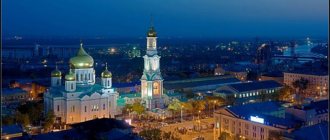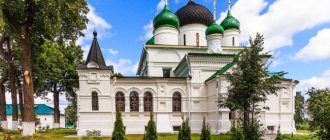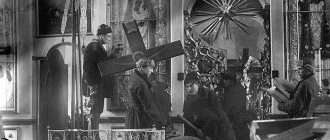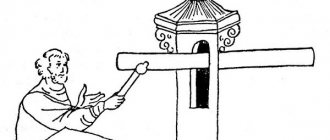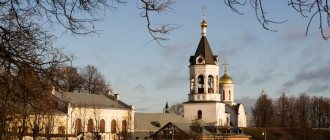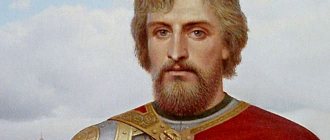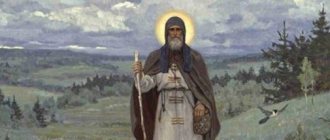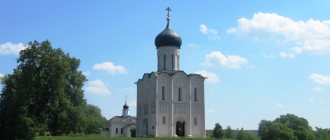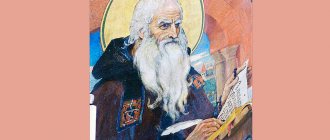Who came after Peter 1?
List of Emperors of Russia
| Emperor | Portrait | Heir |
| Peter I Alekseevich | (1672—1725) | Pyotr Alekseevich, Ekaterina Alekseevna, Anna Petrovna |
| Ekaterina I Alekseevna | (1684—1727) | Pyotr Alekseevich, Elizaveta Petrovna |
| Peter II Alekseevich | (1715—1730) | Elizaveta Petrovna |
| Anna I Ioannovna | (1693—1740) | Anna Leopoldovna |
Death of Svyatopolk the Accursed
According to the chronicles, after the defeat on the Alta River, Svyatopolk fled through Berestye and Poland to the Czech Republic. On the way, suffering from illness, he died.
We can’t endure it in one place, and having run through the Lyadskaya land, we are driven by God’s wrath, running into the desert between Lyakha and Czechs, casting out our evil lives - chronicles
It is noteworthy that the name of such a “negative character” as Svyatopolk continued to be used to name the children of the princely family, for example, Svyatopolk Izyaslavich (1050-1113), son of Izyaslav Yaroslavich, in 1093-1113. - Grand Duke of Kyiv.
The flight of Svyatopolk in the painting by Boris Chorikov
Family of Vladimir I
Children of Vladimir I
Section "Vladimir I"
Who ruled Kiev in 882?
Prince Oleg annexed Smolensk, Lyubech and Kyiv and declared the latter city the new capital of the Old Russian state (Kievan Rus). Establishment of the Varangian Rurik dynasty in Kyiv. Unification of Kyiv and Novgorod.
Interesting materials:
What tales are included in the Tale of Bygone Years? What are the discounts at traffic lights? What layers are distinguished in the structure of the globe? What cases are insured under compulsory motor insurance? What are the coordinating conjunctions? What messages are recorded in the 112 system? What varieties of strawberries are for Siberia? What are the best gooseberry varieties? What varieties of radishes are there? Which social networks do Zuckerberg own?
Later, its folklore-pagan name “Red Sun” penetrated from epics into scientific works.
The Russian Grand Duke Vladimir Svyatoslavovich died 1000 years ago. But his immediate descendants unanimously recognized his merits in the transformation of Rus'. She united all the East Slavic tribes under her rule, becoming one of the largest and strongest powers in Europe.
It was through the works of Vladimir, who continued Olga’s work, that Rus' turned into a genuine state. Vladimir showed himself to be a valiant ruler in war and wise in days of peace, caring for the welfare of all his subjects.
The Russian people remembered Prince Vladimir in their epics as “Vladimir the Red Sun,” the owner of a brilliant heroic court. The Russian Orthodox Church canonized Vladimir, the Baptist of Rus', in the 13th century.
It is difficult for a modern person to understand many of his actions. However, it cannot be denied that it was he who laid the foundations of Russian statehood and united the nation.
From the biography of Prince Vladimir Svyatoslavovich:
Vladimir I the Holy (? - 1015), Grand Duke of Kiev (from 980 - 1015).
The date of birth of Prince Vladimir has not reached our days, but the dates of his reign (980 - 1015) and death are known. He died on July 15, 1015.
The father of Prince Vladimir was the famous commander and at that time the ruler of Kyiv Svyatoslav Igorevich. He was the only son of Igor Rurikovich and Princess Olga, who was the first among Russian rulers to convert to Christianity.
Vladimir was the third, after Yaropolk and Oleg, the son of Prince Svyatoslav Igorevich.
Vladimir's father, the Russian Grand Duke Svyatoslav Igorevich, did not stay long in the capital Kyiv, spending time on distant military campaigns.
Mother, Malusha, was a princely slave, housekeeper of Princess Olga, the first Christian in the Rurik dynasty and mother of Svyatoslav. But condemning Svyatoslav’s paganism, she remained his faithful adviser and ruler of Kyiv until her death. She raised Vladimir, the illegitimate “Robichich,” along with her other grandchildren.
Angry at Malusha, who conceived a son in sin, Olga sent her to the village of Budyatino. And when the boy was 3-4 years old, he, already without his mother, was returned to Kyiv. There he was under the supervision of his grandmother Olga, since pagan laws accepted him as a princely heir. In addition, Vladimir was looked after by his maternal uncle Dobrynya, who was the Kyiv governor.
When his sons grew up, Svyatoslav, who had previously been more interested in military campaigns than in affairs in the lands under his control, distributed them to his sons: Yaropolk received Kyiv, Oleg received the land of the Drevlyans, and Vladimir Svyatoslavich was sent as governor to Novgorod.
Svyatoslav died at the beginning of 972 in a battle with the Pechenegs, returning from an unsuccessful war. But three years before that, he divided his lands between his sons: the eldest Yaropolk became the prince of Kyiv, Oleg received the land of the Drevlyans, and Vladimir was sent to Novgorod with his uncle and teacher Dobrynya. Vladimir lived for several years in the Novgorod land, without claiming the Kiev throne. However, peaceful life soon came to an end.
After the death of his father, internecine strife began. For a minor reason, Oleg killed Yaropolk's comrade-in-arms. He flew into a rage and, at the instigation of the Varangian governor Sveneld - the father of the stabbed warrior - decided to take away the Drevlyan lands from his brother. A battle took place in which Oleg was crushed to death by his own retreating warriors.
Having become the ruler of not only Kyiv, but also the Drevlyan lands, Yaropolk decided to remove Vladimir from the road, especially since he always considered him the son of a slave and placed him below himself.
Realizing the danger threatening him, Vladimir Svyatoslavich went “overseas” to the Varangians in Scandinavia, where he enlisted the support of King Olaf for further struggle against Yaropolk.
When, not having the strength to fight his brother, Vladimir fled from Novgorod, Yaropolk immediately sent his governors there. And so it happened that Yaropolk began to single-handedly rule Russia.
Meanwhile, Vladimir was preparing to return to his patrimony. And in 977, Vladimir returned from across the Baltic Sea with an army in which the majority were Varangian warriors. The Novgorodians immediately went over to his side. Vladimir was able to recapture Novgorod and moved to conquer the lands of the Drevlyans. The local population, grieving for the murdered Oleg, greeted the new prince with delight. Yaropolk's warriors came under the command of Prince Vladimir Svyatoslavovich. Thus, he formed a fairly large army. In 978, the North Russian army moved to Kyiv. Hunger forced Yaropolk to surrender.
So at the end of the 70s of the 10th century, Vladimir again established himself in Novgorod, then took possession of Polotsk and, finally, Kiev. Having fled from there to the Rodnya fortress bordering the steppe, Yaropolk was forced to recognize Vladimir as the ruler of all Rus'. Soon, Svyatoslav’s eldest son was killed under unclear circumstances.
Vladimir understood that it was time for him to part with the Varangian mercenaries, since he did not want the plunder of Kyiv. Before heading there, the prince sent the rest to Constantinople, to serve the Byzantine emperor, promising “mountains of gold.” The deal was successful for both parties, since Constantinople needed warriors to protect them from external and internal enemies.
In order to give legitimacy to his rule, Vladimir Svyatoslavovich decided to enlist the support of the priests. He liked paganism because it justified polygamy and did not condemn him for having a huge number of concubines. To appease the idols, the prince built a temple in his capital. Rituals and sacrifices were regularly held there. Vladimir Svyatoslavovich ordered the main idol Perun to be given the features of himself. The people were impressed by the prince's worship of traditional gods, so they treated the new ruler well.
In addition, the first 10 years of the reign of Vladimir Svyatoslavovich were marked by numerous victories over warlike neighbors, especially in the west, which helped strengthen the borders and allowed the population not to fear raids.
In 981, Vladimir made a campaign against Poland and managed to return to Rus' the cities of Cherven (near present-day Chelm) and Przemysl captured by the Polish prince. Volyn remained with Russia.
In 982, Vladimir’s squads moved to the north-west of the Russian lands, where the Kyiv prince managed to defeat and subjugate the Yatvingians, as well as force other tribes of the Baltic region to pay tribute.
Having become a prince in Kiev, and having ordered the construction of a new idol of the god Perun, which was erected near the prince’s mansion on a “sacred” hill among other pagan idols, Vladimir hoped that these pagan deities would become common to all the tribes that were part of the vast state. However, this first religious reform of Vladimir was not successful, since each tribe continued to worship its own gods. And the Pantheon of gods among the various tribes that inhabited Vladimir’s domain was quite diverse, so paganism prevented the formation of a powerful unitary state. Then the prince thought about accepting a new faith.
Being a far-sighted politician, the prince understood that the country needed a more advanced religion. Then Christianity attracted his attention, especially since its adherents were increasing every day, including among nobles. The same religion was professed by Vladimir Svyatoslavovich’s own grandmother. During his childhood years spent at the court of Princess Olga, he had the opportunity to observe how Kyiv Christians carried out their rituals. In addition, the prince most likely could have had some idea about the salvation of the soul and resurrection after the Day of Judgment.
In 988, Vladimir's army arrived on boats in the Crimea and besieged the main Byzantine city of Kherson (Korsun). After a short siege, the city fell, and Vladimir deprived the Byzantine Empire of its Crimean possessions. In the beginning of the Russian-Byzantine negotiations, it became clear that the Russian prince did not lay claim to Kherson and was ready to return it to the Byzantines, subject to the consent of the co-rulers of the empire - Vasily and Constantine - to his marriage with their sister Anna. But this union could only take place with a Christian and the ruler of a Christian country.
The political aspect of choosing Christianity as the state religion was also important for Vladimir, which promised the strengthening of allied relations with Byzantium.
Prince Vladimir was a famous sensualist and had a large number of wives and concubines. But, having converted to Christianity, he abandoned them and began to live only with Anna, recognizing her as his only wife before God. However, Vladimir’s family idyll was overshadowed by the children’s feuds. The prince had 12 sons, each of whom owned his own lands.
Vladimir's favorites were Boris and Gleb, born to the Bulgarian Milolika. Towards the end of his life, Prince Vladimir decided to bequeath the throne to Boris, causing the indignation of Svyatopolk and Yaroslav, who hoped to inherit him by right of birthright.
The unexpected death of Vladimir in 1015 led to the fact that the senior heirs decided to usurp the throne. Svyatopolk seized power in Kyiv, but realizing that the people were on the side of Boris and Gleb, he ordered their death. His next victim was his brother Svyatoslav. Yaroslav, who took the throne, was able to stop Svyatopolk’s crimes.
The Baptism of Rus' and its historical significance:
Vladimir Svyatoslavich went down in history as the initiator of the baptism of Rus'. This event largely determined the fate of the country and had a fundamental influence on its culture.
But, oddly enough, no reliable records of contemporaries dedicated to this most important event were discovered. Therefore, the testimony of the Armenian chronicler Stepanos (Stephan) Taronsky is especially valuable. He lived at the same time as the prince and was creating the “Universal History” precisely during the period when Vladimir was choosing a new religion for his state. In his work, Stepanos described the events that took place from 885 to 1004.
Remembering the events that took place in the year 1000, he writes about the 6,000 foot army of the Ruzes, which was in Armenia. According to him, these were soldiers who arrived at the request of Emperor Vasily. According to Stepanos, this happened when Vasily gave his sister in marriage to Vladimir.
We also read there that this event coincided with the fact that the Ruz believed in Christ. As for other sources, they confirm Stepanos’s testimony, but provide more detailed information. In particular, many chroniclers indicate that Vladimir decided to marry the sister of the Byzantine emperors, Anna. They agreed, demanding military assistance in the fight against the rebel Varda Foka.
The princess herself opposed the brothers’ decision, but later agreed to become the wife of the Russian prince if he converted to Christianity. The most reliable information about this event is reported by the Syrian historian of the 11th century, Yahya of Antioch.
The version that Vladimir captured Korsun and threatened to do the same with Constantinople if Anna was not given to him cannot be considered valid.
It has been proven that at that time Russian soldiers already helped Vasily the Second in the fight against internal enemies.
According to legend, the wedding flotilla with the princess arrived in Korsun. However, the prince refused to be baptized. The Lord punished him for breaking his word, and Vladimir became blind. Anna persuaded him not to resist, and during the ceremony the prince’s sight returned. God's grace descended on Vladimir, who took the Christian name Vasily. He ordered the boyars and squad to follow his example, and then married Princess Anna.
Returning to Kyiv, Vladimir first ordered his sons to be baptized. Then the prince gathered the inhabitants of the city on the banks of the Dnieper. On his orders, a mass baptism took place, which no one dared to oppose. To convert residents of other cities to Christianity, the prince called priests and educators from Greece.
To strengthen the new faith, Vladimir ordered the construction of a temple of the Most Holy Theotokos and a tenth of all state income to be given to the church.
Special educational institutions were created to train local clergy. In addition, a church charter was published, called the Helmsman's Book, and on Mount Athos Vladimir acquired a monastery for Russian monks. Mass construction of churches began in all corners of the state. These are the historical evidence of the baptism of Rus'.
Its greatest historical significance cannot be overestimated.
Christianity brought a lot to Rus':
1. Russia entered, as an equal, into the family of European Christian nations.
2. The Slavic alphabet spread in Rus'. The first books were copied - first copies of the Slavic translation of the Bible.
3. Byzantine stone architecture and icon painting were transferred to Rus'.
4. Christianity gradually permeated the entire emerging Russian culture.
Political, diplomatic and military achievements of Prince Vladimir:
By the mid-980s, almost all East Slavic lands were united by Vladimir under the direct rule of Kyiv. No Russian prince has achieved such success.
In the capital, he created a sanctuary of the five highest pagan gods, led by Perun. Perhaps the pagan reform was supposed to become a symbol of the submission of the southerners to the new illegal prince. But the main thing during this period was a radical turn not in religion, but in politics.
In 985, Vladimir defeated the Volga Bulgarians. But he did not, as usual, impose an unreliable tribute on the country, but concluded an equal peace and an eternal alliance. The chronicle testifies that it was decided this way on the advice of Dobrynya’s faithful uncle and comrade-in-arms. Having walked around the prisoners, he said: “I examined the convicts - everyone was wearing boots. We cannot give these tributes. Let’s go find some bast shoes for ourselves.”
The strange phrase seemed to mean a change in the entire political line of Rus'. It was no longer semi-robbery raids on neighboring lands for one-time “tribute” that came to the fore. The task was proclaimed to be a painstaking gathering of the “lapotniks” of Eastern Europe - Slavs, Balts, Finns - under the rule of the Kyiv prince. Not the ruin of foreign states, usual for the peoples of the tribal era, but the construction of their own state. It is not at all accidental that this was soon followed by the baptism of Rus'.
In 987-988, Vladimir negotiated with Byzantium about his baptism and marriage to Princess Anna, promising in return to provide military assistance to Emperors Vasily and Constantine. The prince kept his word, but his counterparts insidiously walked away from their obligations. Then Vladimir made a campaign against Chersonesus, the center of Greek possessions in Crimea, captured the city and took Anna as his wife. Whether he was baptized then or even before the campaign, historians differ in their opinions.
But, returning to Kyiv, the prince ordered the destruction of the temple he had erected with pagan idols. All Kiev residents were ordered to gather at the confluence of the Pochayna River into the Dnieper. There the Greek priests, who arrived with Vladimir from Chersonesus, baptized the people - right in the river waters.
But how historical is the chronicle narrative, so rich in colorful details? After all, “The Tale of Bygone Years,” the most famous chronicle of Ancient Rus', was created only at the beginning of the 12th century. Behind a series of events that we see as real history, the chroniclers were looking for God's parable, the highest meaning. Under their pen, Vladimir was likened either to the biblical patriarch Jacob, or to the righteous King Solomon, or to the first Christian emperor Constantine, as if repeating their deeds in Rus'.
Under Vladimir Svyatoslavich, the first Russian coins were minted from gold and silver. To protect the state, he built several fortified cities and appointed his sons as rulers. In the last decade of his life, he made almost no aggressive campaigns and periodically took up arms only to repel the endless raids of the Pechenegs.
Vladimir paid a lot of attention to protecting the southern borders of Rus' from the raids of nomads. During his reign, protective ramparts were built on the steppe border of Rus', fortresses where squadrons carried out border service. Hence the epics about the “heroic outposts” where the guards stood - the heroes Ilya Muromets, Dobrynya Nikitich and Alyosha Popovich.
Since its baptism, Rus' has become a full participant in historical and cultural processes in the world of Christian civilization. Vladimir Svyatoslavovich, who was later canonized and became Vladimir the Saint, is one of the prototypes of the epic prince Vladimir the Red Sun.
Interesting facts, legends and myths about Prince Vladimir:
Legends and myths about a man who passed away 1000 years ago are inevitable. But at all times, judgments about the Baptist of Rus' were not unambiguous. And how could it be otherwise if he lived on a tectonic fault between two eras - pagan and Christian? If you started your life's journey as a violent pagan warrior, and ended as a righteous Christian?
Over 1000 years, this historical figure has accumulated the most incredible appearances. By the beginning of the 20th century, historians had collected a collection of portraits: now we see something mythological, almost with an ancient Persian reflection, then something warlike, dangerous, looming - in the Varangian manner... and then - something domestic, cool and powerful - a kind of premonition of Ivan the Terrible.
The beginning of the 21st century is moving away from these portraits: there is an attempt to understand what the ruler, whose monument will rise above Moscow, really was.
Of course, it is not easy 1000 years later to decide what in the prince’s appearance was “really” and what was conjectured by memoirists, chroniclers and inspired creators of legends. But in every conjecture there is hidden an objective necessity, which is revealed by conjecture. But we must be aware that the stories that have reached us have come down to us because they meet the needs of our spirit, and if we believe in these episodes, it is precisely because our soul asks for it today.
Where do the myths end and the real (as far as it is possible to discern them between the chronicle lines) facts about the Grand Duke begin?
What do we know about Vladimir from historical sources? Leafing through the pages of ancient chronicles and scientific works, it is often difficult to understand: how does one or another ruler become a hero of great History? And you often get the feeling: those whom we now consider heroes were almost villains for their era. But something else is also true - those whom antiquity chose as heroes and saints were children of their harsh centuries. And their contemporaries did not doubt their merits. Now, in our modern opinion, the stormy and cruel passions of the past millennia can terrify us to the point of losing our sight. And before the loss, the main thing is to distinguish.
1. The prince had 5 wives and another 500 concubines. But who could calculate who the prince sent away in his youth? But the point is not this, not the texture that has sunk into oblivion - the point is how to reconcile that sensualist and this owner of the feast, who sits next to his lawful Apraksievna. And in order to reconcile this and that, we must, perhaps, also remember how the prince obtained for himself the legitimate Anna, the Byzantine princess, promising military assistance to the Greeks for her. The Greeks deceived the prince, then he captured Chersonesos (the center of the Greek possessions in Crimea) and finally received a betrothed wife. There were poets who extracted from this episode the “Kherson” carrot and half the poison: either you baptize those who want to be baptized, or you baptize by force. How are such episodes reconciled in the fate of an individual? Unbridled aggressiveness and unbridled humility? Savagery and civilization look at each other at the turn of the era?
2. Another famous plot, abundantly commented on by retellers: the dispute between the prince and religious teachers, called upon to choose the right faith for Russia. In fact, there is no need to call them: the Jews are regularly trading in Kievan Rus, and the Islamized Bulgarians are nearby, and there is nothing to say about Catholic Rome - it is truly looming. And disputes like the one in Korsun are commonplace: multi-vector religiosity plows through the pagan Dnieper region. So why should Vladimir look for a common new faith? To compensate for the heat of lust, to tame the violence of one’s younger years? To some extent, yes. But this is not the main thing in disputes. The main thing is the state's geopolitical instinct, which Prince Vladimir is endowed with.
3. The prince senses: only a powerful, great, grandiose power can survive in this Eurasian boundlessness. And so it happened: the Khazars did not unite it - the Horde rallied it, and the Horde retreated - the Russians held it.
Intuitively sensing the task, the Slavic prince takes a closer look at the religious teachers, wondering what idea can unite these tribes wandering across the borderless. This is what he is trying to find out, although in his arguments every now and then he gets off with jokes. Question to the Jews: where is the homeland? (He knows that they do not have a homeland, but galut, total wandering.) With Muslims, sensing the scale of the task, he laughs it off, throwing to his compatriots an intoxicating testament: “The joy of Rus' is to drink,” leaving the joy of sobriety to Islam. Greece is not in any danger. Contacts with Orthodoxy are real. Although there is an ancient temptation: to plunder Constantinople. And in the end we received the Orthodox Power - from the cold Finnish rocks to the fiery Colchis. If we had not fulfilled this covenant, others would have fulfilled it. On the same scale. And at the same price. And a striking nuance also helped matters: the shoe.
4. The teacher and comrade-in-arms of Prince Dobrynya, after their next victorious campaign to the neighbors, examining the captured prisoners, noticed that they were all wearing boots! Another unsurpassed phrase instantly went down in history: “Let’s look for some bast shoes!” This meant that what was needed was not banditry raids on neighbors, but the painstaking gathering of the efforts of millions of ordinary workers. Lapotniki did not disappoint. Having thrown off their boots, they reached the “two great oceans” and created the Russian State. Here it stands for the second thousand years.
5. The victory was celebrated by a brave warrior and a daring reveler - you can’t erase a word from the song. Moreover, from The Tale of Bygone Years:
“Vladimir was overcome by lust. He had wives: Rogneda, whom he settled on Lybid, where the village of Predslavino is now located, from her he had four sons: Izyaslav, Mstislav, Yaroslav, Vsevolod and two daughters; from a Greek woman he had Svyatopolk, from a Czech woman - Vysheslav, and from another wife - Svyatoslav and Mstislav, and from a Bulgarian woman - Boris and Gleb, and he had three hundred concubines in Vyshgorod, three hundred in Belgorod and two hundred in Berestovo, in the village, which They call it now Berestovoe. And he was insatiable in fornication, bringing to himself married women and corrupting girls. He was as much a womanizer as Solomon, for they say that Solomon had seven hundred wives and three hundred concubines.”
And although there is no reason to doubt the voluptuousness of Vladimir the pagan (Thietmar of Merseburg also speaks about this in the Chronicle, and he notes that Vladimir the Christian did not immediately abandon his vicious inclination), for the chronicler the main thing is not factual accuracy, but the parallel with Solomon. He, too, was voluptuous, and this led him away from God, while Vladimir, on the contrary, came from fornication and paganism to God through the “good wife,” Princess Anna.
6. Traits of a real personality sometimes appear where, at first glance, we are talking about a literary image, a cliché. In chronicles and lives, Vladimir is especially glorified for his alms. The feasts of the “affectionate prince Vladimir”, accessible to everyone, were remembered in epics.
The first Russian writer, 11th-century Metropolitan Hilarion, showed Vladimir as a generous and merciful defender of all those who suffer. Moreover, the contemporary German chronicler Thietmar, who spoke harshly of Vladimir, also speaks of him as a beggar-lover and alms-giver. This looks very much in contrast to the previous characterizations of Vladimir as a woman-lover and a persecutor of Christians.
In general, Thietmar's story about Vladimir is filled with contrasts. Just like, one must think, the true life of the prince. This is one of the most exciting topics. But not one of the oldest sources - neither Russian nor foreign - says a word about this. The prince threatened those who were not baptized that they would “be his enemies,” but, according to all data, there were no such people in large cities.
For a pagan Slav, the prince was the highest authority in religious matters. And the fact that he destroyed the idols with impunity destroyed faith in the power of the gods. The people of Kiev mourned the broken Perun, but were baptized without any resistance and even with joy - at least outwardly. The same thing happened throughout almost the rest of Rus'.
Only in Novgorod, according to a very late legend, were there clashes. And the Novgorod governor Dobrynya allegedly had to use force. But only one source speaks about this - the so-called. Joachim's Chronicle, preserved only in the work of the 18th century historian V.N. Tatishcheva. The latter received it from his relative, Archimandrite M. Borshchov, whom he persistently asked for some ancient manuscript. The manuscript was found and, as expected, “confirmed” many of Tatishchev’s guesses about the ancient history of Rus'. There are many oddities and contradictions in the text, and Tatishchev himself wrote about the monk Veniamin, who supposedly provided the manuscript to Borshchov, that he was “made up only for closure.” So the Joachim Chronicle does not go back to the time of Vladimir, and cannot serve as a reliable source - even if it is a compilation and not a pure forgery. There is not the slightest evidence of the baptism “by fire and sword” of all Rus', even in the Joachim Chronicle.
7. Legends and contradictory versions inevitably appeared around Epiphany. Even the place of Vladimir’s baptism is indicated differently. According to a number of sources, he was baptized in Kyiv in 988. The same year is considered the date of the baptism of Rus'. Although, according to many scientists, the country was baptized only in 989 - it was then, according to the contemporary events of the Byzantine author Leo the Deacon, that the Rus took Chersonesos. Consequently, no earlier than this year, Vladimir had to make peace with Byzantium and marry Anna.
And, of course, to us, distant descendants, it seems not entirely possible for the miraculous transformation of a sinner into a righteous man in such a short time. But it is necessary to critically analyze everything that we know about Vladimir.
The fact that he fought with the Greeks already baptized is confirmed by another contemporary - the German chronicler Thietmar of Merseburg.
But, according to the chronicle legend, at the moment when Vladimir won Anna’s hand, a sudden illness happened to him - blindness. Anna, who arrived in Korsun, advised the prince to be baptized as a means of healing. Vladimir listened and was healed.
Blindness is spoken of in many ancient Russian sources reporting on the baptism of Vladimir. But what is meant is mental blindness, which is shown to readers through a physical illness that supposedly overcame the prince. Spiritual blindness passed after finding Christ and understanding faith - and on the advice of Anna, the biblical “good wife” who turns her husband to goodness and God. Thanks to her, Vladimir becomes a Christian and a wise ruler.
8. Later, a legend was compiled about Vladimir’s “choice of faith”: he allegedly hesitated between Judaism, Islam, Western (“Roman”) Christianity and Eastern (“Byzantine”) Christianity, ultimately preferring the latter.
9. 12 sons are attributed to Vladimir, and from the lists in the chronicle itself this number is not entirely obvious. Moreover, if the prince really (as stated in the same chronicle) had hundreds of concubines, then most likely there should have been more children. Meanwhile, for the chronicler in this case, what was significant was not reality, but the sacred load that was invested in the number 12. The twelve children of the Grand Duke are the twelve patriarchs, from whom will come the twelve tribes of the Christian “new Israel,” the descendants of the Russian great princes.
Monument to the 1000th anniversary of the Baptism of Rus'
Memory of the Russian Grand Duke Vladimir Svyatoslavovich:
The reign of Vladimir is an extremely important stage in the creation of a unified state past of Russians, Ukrainians and Belarusians. And each of the three nations preserves the memory of him both in scientific works and in folk tradition. This is what we have in common.
For his greatest services in creating the Russian state, Vladimir Svyatoslavovich was canonized by the Orthodox Church.
In addition, he is revered by Catholics, since he lived before the Ecumenical Schism.
Every year on July 15 in Russia and in many other countries the day of his memory is celebrated.
Monuments to Saint Vladimir were erected in Moscow, Kyiv, Sevastopol, Belgorod and other cities, and a temple was built in his honor on the territory of Chersonesos.
The state preserves the memory of those Slavs who gave the country soil, a common language, a common destiny.
The prince, who died in 1015, is a saint in the synodics of believers, and in folk tales, epics and fairy tales - a cheerful, generous, affectionate, eternally feasting, hospitable host. Bogatyrs perform feats, and in the end they are rewarded, so much so that in the memory of the people, Prince Vladimir Svyatoslavovich exists precisely as the Red Sun. Yes, something that has not gone out in 1000 years, and hopefully will never go out, as long as Russia exists and we are in it.
Monument to Prince Vladimir in Moscow
photo from the Internet
